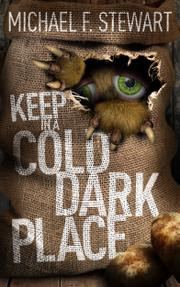| ________________
CM . . . . Volume XXIV Number 22. . . . February 9, 2018
excerpt:
Limphette (Limpy) O’Malley lives on a potato farm with her father and two older brothers. Her mother died when Limpy was born, and life has always been hard for the family. Even though she knows her father is against the idea, Limpy dreams of going to art school and is working on a project to win a scholarship. Her older brothers work on the farm all day with their father. The farm is facing foreclosure when Limpy finds something buried in the dirt under the potato cellar. Inside an old box are four eggs which hatch one by one into small fluffy creatures. Limpy doesn’t know what the creatures are, but she starts to raise them. One creature disappears, and soon unexplained things start to happen around the farm and to Limpy at school. Limpy finally translates the writing on the box she found the eggs in: “Keep in a cold, dark place. Beware of the Chupacabra!” Limpy discovers that the chupacabra have caused problems in the town before, but no one believed the stories except for a local storekeeper. She has to figure out how to stop the chupacabra before they destroy her family’s farm and her family. Keep in a Cold Dark Place is an interesting story about fear and how fear can trap you. Limpy’s family has been trapped by the death of Limpy’s mother and by their farm, unable to live their lives the way they want to. They are not the only ones in the town who feel trapped by their circumstances, but they appear to be the characters the least able to change their futures. The story is set in a small town, presumably in current times. There are computers in the library, but much of the setting feels like it is older. This is reinforced by the characters and their interactions with one another. There is very little reference to modern technology or to current events, leaving the reader to generally pick what time period they feel the story belongs in – the 1920s, the 1950s or the present day. The lack of time references enhances the story as it makes the recurrence of the chupacabra seem more inevitable and gives an element of magic realism to the story. Limpy is a reasonably realistic 13-year-old. Sometimes she acts older, sometimes she acts younger, but she is the youngest child of three and has been forced to take on a lot of responsibility at a young age. In addition to helping on the farm, Limpy has had to take on all the domestic chores, including the cooking. Limpy’s father expects her to give up her dreams and to work on the farm as her brothers have had to do. Limpy is determined to go to art school and, for much of the story, is working on a project to win a scholarship. Limpy is the only character that the readers really get to know in the story, in part because the story is seen only through her eyes. Although the narrative is in the third person, there is limited omniscience, and the reader only knows and sees what Limpy knows and sees. While this makes the reader relate more closely to Limpy, it leaves the other characters less developed and more stereotypical. The readers need to know about the O’Malleys and Limpy’s friends, the Josés, as this is important to the ending of the story. The reader does learn about the O’Malleys through their interactions with each other, but much of the character development occurs towards the end of the story. The way the O’Malleys come together and become a much closer family seems almost too good to be true but works well within the story. Keep in a Cold Dark Place is a well-paced story about fear, family and determining one’s future. Using the myth of the chupacabra allows Michael F. Stewart to explore these themes in a way that will appeal to the intended audience. Recommended. Daphne Hamilton Nagorsen is a graduate of the School of Library, Archival and Information Studies at UBC, Vancouver, BC.
Next Review |
Table of Contents for This Issue
- February 9, 2018. |
